|

The
university was founded in Berlin in 1810, and the founding concept by
Wilhelm von Humboldt was the vision to be the "Mother of all modern
universities". This concept envisaged a "Universitas litterarum",
a vision to unit teaching and research and to provide students with
an all-round humanist education. This concept spread throughout the
world and served as the foundation of many universities of the same
type over the next century and a half.
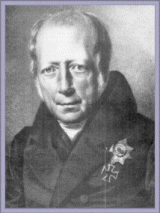
The
concept of the academician and statesman Wilhelm von Humboldt was influenced,
among others, by the reform ideas of the philosopher Johann Gottlieb
Fichte, the first vice chancellor of the university, and by the theologian
and philosopher Friedrich Schleiermacher. From the outset, the university
in Berlin had the four classical faculties of Law, Medicine, Philosophy
and Theology. Its first academic term began with 256 students and teaching
staff of 52. Professors such as Georg
Friedrich Wilhelm Hegel (Philosophy), Karl Friedrich von Savigny
(Law), August Boeckh (Classical Philology), Christoph Wilhelm Hufeland
(Medicine) and Albrecht Daniel Thaer (Agriculture), shaped the profile
of the individual faculties in accordance with Humboldt's concept. Partly
due to the influence of the natural scientist Alexander von Humboldt,
the university was a pioneer in introducting many new disciplines. The
chemist August Wilhelm von Hofmann, the physicist Hermann von Helmholtz,
the mathematicians Ernst Kummer, Leopold Kronecker, Karl Theodor Weierstrass
(the "triple star of Mathematics"), and the medical scientists
Johannes Müller and Rudolf Virchow became known in their specialist
areas far beyond the university in Berlin.
Later,
a total of 29 Nobel Prize winners did some of their scientific work
at the university in Berlin, including Albert Einstein, Emil Fischer,
Max Planck and Fritz Haber. And many famous people such as Heinrich
Heine, Adelbert von Chamisso, Ludwig Feuerbach, Otto von Bismarck, Karl
Liebknecht, Franz Mehring, Alice Salomon, Karl Marx and Kurt Tucholsky
were also enrolled at the "Alma mater" of Berlin. Heinrich
Mann was the first honorary doctor of the university after the end of
the Second World War.
The
Prussian king, Friedrich Wilhelm II, donated the first building to the
university - the former Palace of Prince Heinrich of Prussia. It was
built from 1748 to 1766 on the splendid boulevard Unter den Linden,
and it saw major extension work from 1913 to 1920. When the Royal Library
was no longer sufficient for teaching requirements, a university library
was established in 1831. During the expansion of the university - since
1828 is had been called "Friedrich Wilhelms-Universität"
- other institutions that already existed in the city were integrated.

One
example is the still famous Charité. Friedrich I had built a
quarantine house outside the city walls to counter the threat of the
plague. This "plague house" was used to accommodate the poor,
ill, and the frail. As early as 1726, in its function as a military
and citizens' hospital, this building was turned into a training centre
for military medicine and a school for doctors and surgeons. In 1727
the "soldier king" Friedrich Wilhelm decreed: "The building
is to be called the Charité". The Faculty of Medicine took
over the building in 1829. When establishing natural science institutions
in the second half of the 19th century, highly modern research and teaching
facilities arose. The school for treating animal medically was founded
in 1790 and was integrated as the Faculty of Veterinary Medicine; the
agricultural college founded in 1881 became the Faculty of Agriculture.
In 1889 a building was opened at Invalidenstrasse 43 for the natural
history collections that had belonged to the university since 1810.
This building is now the Museum of Natural History. The close links
between the clinical and pre-clinical facilities of the Faculty of Medicine
created a generous spatial connection between scientific disciplines
at the turn of the century.
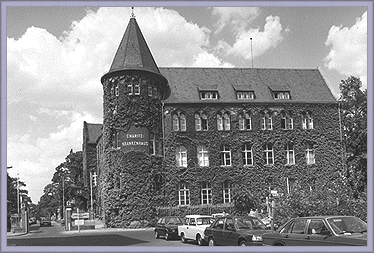
The early decades of the 20th century were characterized by great academic
achievements and international attractiveness. In 1901, Jacobus Henricus
van't Hoff from the Netherlands received the university's first Nobel
Prize for Chemistry for his research into the laws of chemical dynamics.
The antiquity expert Theodor Mommsen published trendsetting work on
Roman history, and in 1902 he received the Nobel Prize for Literature.
27 other Nobel Prizes reflect the outstanding scientific achievements
of the academics who worked at the university in Berlin. The chemist
Walter Nernst and the physicists Max von Laue, Gustav Hertz and James
Franck are worth noting. Emil von Behring received the first Nobel Prize
for Medicine for the development of an effective cure for diphtheria,
and some years later Robert Koch, who discovered the tuberculosis and
cholera bacteria, also obtained the Nobel Prize.
When
the latest Nobel Prize for a (former) member of the university was awarded
to the co-founder of quantum mechanics Max Born in 1954 for "Establishing
a new way of thinking about natural phenomena" (Born), the university
had been through a dark chapter of German history: the expulsion of
Jewish academics and students and political opponents of National Socialism,
and the extermination of some, did great damage to the university in
the period from 1933 to 1945. And it was a shameful moment for the university
when students and lecturers took part in the burning of books on 10th
May 1933. After that and in the subsequent war years, many academicians
left the university which had once been renowned as the home of humanitarian
thoughts. Weakened by this great loss of scientific potential, teaching
was resumed in January 1946 with seven faculties in partly war-damaged
buildings. The political turmoil of the post-war period and the protest
of students and lecturing staff against the increasing Communist influence
on the university led to a division among the staff and students. As
a result, the Freie Universität Berlin was founded in December
1948 in the American sector of the city.
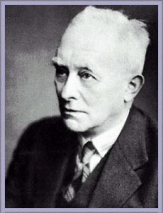
From 1949, the university bore the names of the brothers Alexander and
Wilhelm von Humboldt. However, the university reforms of 1950 and 1967/68
caused the university to develop in a way that ran counter to its former
academic traditions and changed the academic content, study procedures
and research conditions in obedience to the ruling ideology. Nevertheless,
it was still possible in some areas to restore international contacts
and create world-wide cooperation. The longstanding and intensive research
and exchange links with the universities in Eastern Europe and particularly
in the former Soviet Union are worth special mentioning; many of these
links are without parallel in Germany. In addition, formal academic
cooperation with nearly all universities in the capital cities of Western
Europe has existed since the 1970s. Close relations to universities
in Japan and the United States, as well as Asian, African and Latin
American countries have been in place for some time. Following German
unification in 1990, Humboldt-Universität seized the opportunity
to enhance international components in both teaching and research, and
to increase the mobility of its students. This was done with an explicit
continuation of previously existing international cooperation and exchange
agreements.
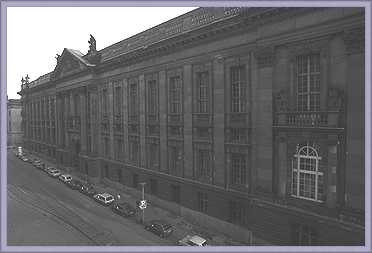
Future development is focused upon three areas: the strengthening of
contacts within the EC, especially under the auspices of the Sokrates/Erasmus
Program; the cultivation of academic and student exchange opportunities
with North American universities and colleges; and the stabilization
of relations with partner institutions in Central and Eastern Europe.
The university currently maintains formal contact to nearly 100 academic
institutions on all continents, and holds more than 450 formal contracts
within the Sokrates Program. Students from over 100 different foreign
countries are presently enrolled at Humboldt-Universität. Foreign
students comprise 11,9% of the entire student population.
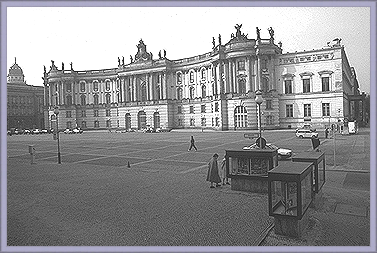
Due to the unification Berlin maintains three universities. Thus, arising
from the problems connected with the unification process, Humboldt-Universität
went through an extraordinary process of reorganization and succeeded
in gaining outstanding scientists and scholars from East and West, from
Germany and abroad. With the aid of partly external structural and appointment
commissions and with numerous expertises and recommendations from groups
of experts, Humboldt-Universität developed its own new academic
structures. The content was evaluated, changed and redefined. At the
same time, the entire staff was subjected to personal and academic scrutiny.
Financial restrictions and structural factors led to a drastic reduction
in personnel.
As a result of the internal restructuring process, Humboldt-Universität
today is made up of eleven faculties and two central institutes. The
present Medical Faculty Charité of Humboldt-Universität
zu Berlin has become the largest medical faculty in Europe as a result
of the merger of the University Clinic Charité with the Virchow
Clinic of Freie Universität Berlin.
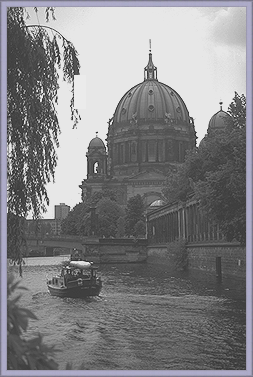
The teaching and research profile of the university covers all the basic
academic disciplines in the Arts, in Social Science, Cultural Science,
Human Medicine, Agricultural Science, Mathematics and Natural Science.
Today, 224 subject study courses or course combinations are offered
at Humboldt-Universität. 19 disciplines lead to the "Diplom"
degree, and there are also "Diplom" degree courses in Interpreting
and Translation for twelve languages, including several Ea stern European
languages. The degree of "Magister" can be obtained in 59
different subjects The range of study courses also includes the courses
leading to the "Staatsprüfung" degree, i.e. Law, Medicine,
Dentistry and Pharmacy (to be discontinued), and the university and
church exams in Protestant Theology. A wide range of study courses for
teaching qualifications is offered, including the teacher qualification
for special schools with the associated specialization areas. New courses
are new and unique: 'The Reformed Medical Curriculum", "Postgraduate
Master in British Studies", "Transatlantic Masters",
"Master of European Sciences", International Health",
"Gender Studies" and "International Agricultural Sciences"
, For this wide range of study courses, there were 37,655 students enrolled
for the winter term 2001/2002. The offers for additional studies, further
studies and supplementary studies will be extended further over the
coming years. Humboldt-Universität has also begun again to offer
correspondence study courses which were formerly so much in demand,
Moreover, much is offered in the area of further scientific instruction,
interdisciplinary and public lectures, and the Faculty of Medicine offers
"Senior citizen courses".
In many areas, research at Humboldt-Universität is internationally
acclaimed, for example in Mathematics, Medicine, Physics, Chemistry,
Biology, History, Cultural and Art Studies, Scandinavian Studies, Economics
and Law. In eight collaborative research areas Humboldt-Universität
is the coordinating university. There are 18 graduate research groups
coordinated by Humboldt-Universität and one Innovation College.
Numerous projects have been implemented with the support of the European
Union. The university participates in 11 special research projects of
other universities, eight further graduate research groups and six research
groups sponsored by the German research association (DFG). Ten foundation
professorships have been established. Researchers representing a variety
of projects have participated in national and international fairs, such
as the CeBIT computer fair, the annual Hannover Fair and the agricultural
exhibition "Internationale Grüne Woche". Almost 70 projects
are currently sponsored by trusts and foundations (VW Foundation, German
Science Sponsorship Association etc). The university's success in continuing
or resuming traditional partnerships and the interest shown by renowned
universities from all over the world show clearly that Humboldt-Universität
plays an important and accepted role in the global scientific dialogue.
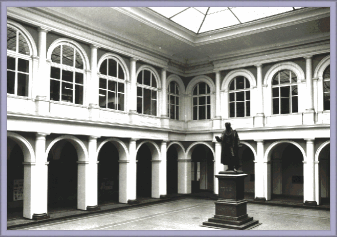
The cramped accommodation of the mathematical and scientific institutions
in Berlin Mitte led to discussions within Humboldt-Universität as
early as 1991 on the possibility of combining them in Berlin-Adlershof.
In the winter term l998/99, the Department of Computer Science was the
first Humboldt department to move to Adlershof, and there was hardly any
campus atmosphere. The mathematicians left their locations in Berlin-Mitte
in March 2000, the chemists in September 2001. They now teach and research
in Adlershof. By 2003 the geographers, physicists and psychologists will
have moved into their own buildings. The biologists will move to their
new abode in Adlershof in 2007. The heart of the new campus is the Johann
von Neumann-Haus. Under one roof it houses a computing centre, a library
and a multimedia centre.
As
a result of the difficult financial situation of the federal state of
Berlin and the resulting extreme austerity requirements, Humboldt-Universität
is moving directly from the "building up phase" of recent
years to a phase of reduction. The university tries out new decision-making
structures; organizational forms and study course structures.
Despite of its unsteady and turbulent history over several decades,
the Humboldt-Universität zu Berlin has remained true to its principles
concerning the unity of research and teaching.
|